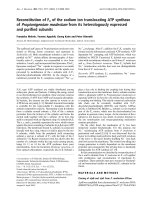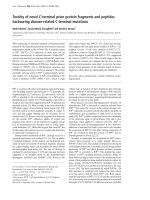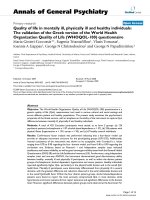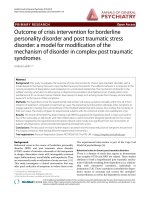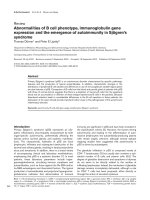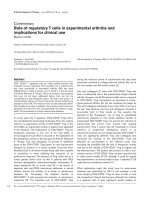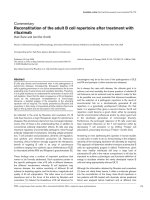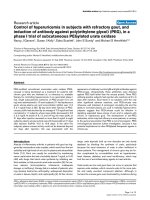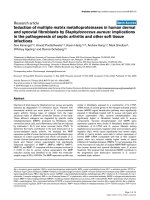Báo cáo Y học: Reconstitution of Fo of the sodium ion translocating ATP synthase of Propionigenium modestum from its heterologously expressed and purified subunits pdf
Bạn đang xem bản rút gọn của tài liệu. Xem và tải ngay bản đầy đủ của tài liệu tại đây (304.47 KB, 7 trang )
Reconstitution of F
o
of the sodium ion translocating ATP synthase
of
Propionigenium modestum
from its heterologously expressed
and purified subunits
Franziska Wehrle, Yvonne Appoldt, Georg Kaim and Peter Dimroth
Institut fu
¨
r Mikrobiologie, Eidgeno
¨
ssische Technische Hochschule, Zu
¨
rich, Switzerland
The atpBandatpF genes of Propionigenium modestum were
cloned as His-tag fusion constructs and expressed in
Escherichia coli. Both recombinant subunits a and b were
purified via Ni
2+
chelate affinity chromatography. A func-
tionally active F
o
complex was reassembled in vitro from
subunits a, b and c, and incorporated into liposomes. The F
o
liposomes catalysed
22
Na
+
uptake in response to an inside
negative potassium diffusion potential, and the uptake was
prevented by modification of the c subunits with N,N¢-
dicyclohexylcarbodiimide (DCCD). In the absence of a
membrane potential the F
o
complexes catalysed
22
Na
+
out
/
Na
+
in
-exchange. After F
1
addition the F
1
F
o
complex was
formed and the holoenzyme catalysed ATP synthesis, ATP
dependent Na
+
pumping, and ATP hydrolysis, which was
inhibited by DCCD. Functional F
o
hybrids were reconsti-
tuted with recombinant subunits a and b from P. modestum
and c
11
from Ilyobacter tartaricus.TheseF
o
hybrids had
Na
+
translocation activities that were not distinguishable
from that of P. modestum F
o
.
Keywords: ATP synthase; F
o
; reconstitution; Na
+
trans-
location; subunit a; subunit b.
F
1
F
o
type ATP synthases are widely distributed among
eukaryotes, plants and bacteria. Utilizing the energy stored
in an electrochemical ion gradient, these enzymes catalyse
the synthesis of ATP from ADP and inorganic phosphate.
In bacteria, the enzyme can also operate in reverse as an
ATP-driven ion pump [1–3]. Detailed structural knowledge
is available for the water-soluble F
1
headpiece with the
subunit composition a
3
b
3
cde. Alternating a and b subunits
form a cylinder around subunit c.Partofthec subunit
protrudes from the bottom of the cylinder and forms the
central stalk together with the e subunit. At its foot, this
stalk is connected with an oligomeric ring of c subunits [4,5].
The c, e,andc
n
assembly represents the rotor, which rotates
against the stator consisting of subunits ab
2
a
3
b
3
d upon ATP
hydrolysis. The membrane-bound F
o
subunit a is connected
laterally with the c ring, where it is held in place by the two
b subunits, which form the peripheral stalk connecting
subunit a and an a subunit of F
1
with the help of the d
subunit [6–11]. Recent structural work has shown that the
number of c subunits within the ring varies among species,
being 10, 11 or 14 for the ATP synthases from yeast
mitochondria, from the bacterium Ilyobacter tartaricus,or
from spinach chloroplasts, respectively [4,12,13]. Subunit c
plays a key role in binding the coupling ions during their
translocation across the membrane. Each c subunit contains
either a glutamate (cE65 in Propionigenium modestum)or
aspartate (cD61 in Escherichia coli) residue that contributes
to coupling ion binding. This strictly conserved carboxylate
side chain can be covalently modified with N,N¢-
dicyclohexylcarbodiimide (DCCD), and thereby ATPase
activity is inhibited [14]. Besides c
n
, subunit a is an essential
part of the F
o
motor, which uses the electrochemical ion
gradient to generate rotary torque. As the structure of the a
subunit is not known in any detail, its precise function in
the ion translocation and torque-generating mechanism
remains speculative.
On the other hand, the mechanism of F
o
has been
intensively studied biochemically. For this purpose, the
Na
+
translocating ATP synthase from P. modestum is
particularly well suited [15,16]. It was discovered that the
motor in its idling mode performs back and forth rotations
of the rotor vs. the stator thereby shuffling Na
+
ions back
and forth across the membrane. The switch from idling into
torque generation is strictly dependent on the membrane
potential and consequently this driving force is kinetically
indispensable for ATP synthesis [17–19].
In this communication we describe the overproduction of
the a and b subunits from P. modestum in E. coli together
with purification and reconstitution of functional F
o
complexes. These methods open new avenues for biochemi-
cal and mutational studies on individual F
o
subunits in the
future.
MATERIALS AND METHODS
Cloning of
atp
B and
atp
F from
P. modestum
ATPase
AtpB was amplified from chromosomal P. modestum DNA
(DSM2376) by PCR using primers Pma1V [5¢-TAAATGG
Correspondence to P. Dimroth, Institut fu
¨
r Mikrobiologie,
Eidgeno
¨
ssische Technische Hochschule Zu
¨
rich, ETH-Zentrum,
CH 8092 Zu
¨
rich, Switzerland.
Fax: + 41 1 632 1378, Tel.: + 41 1 632 5523,
E-mail:
Abbreviations:DCCD,N,N¢-dicyclohexylcarbodiimide; IPTG,
isopropyl-2-D-thio-galactopyranoside; DTT, 1,4-dithio-
DL
-threitol;
Bistris/propane, 1,3-bis-[tris-(hydroxymethyl)-methylamino]-
propane; DY, transmembrane electrical potential.
(Received 10 December 2001, revised 8 March 2002,
accepted 9 April 2002)
Eur. J. Biochem. 269, 2567–2573 (2002) Ó FEBS 2002 doi:10.1046/j.0014-2956.2002.02923.x
AGACATATGAAAAAAATGG-3¢ (NdeI)] and Pma889R
[5¢-TGTTTAAAACTGGATCCAACTAATCTTC-3¢
(BamHI)]. The resulting 902-bp fragment was cloned into
vector pET16b resulting in plasmid pPmaHisN. AtpFwas
cloned by a similar approach into vector pET23a using
oligonucleotides Pmb1V 5¢-GAGGTAGACCATATGG
CACCAC-3¢ (NdeI) and Pmb504R 5¢-ACTTGTGCT
TGGATCCTTTCTCTTC-3¢ (BamHI) for PCR. The result-
ing plasmid was digested with EcoRI and NotI, filled with
Klenow polymerase and religated to obtain plasmid pPmb-
HisC. The nucleotide sequences of the cloned DNA
fragments were confirmed by the dideoxy chain termination
method [20].
Heterologous expression of the genes encoding
the
P. modestum
subunits a and b in
E. coli
E. coli C43(DE3) [21] was transformed with plasmids
pPmaHisN or pPmbHisC, respectively, and the cells were
grown in 2 · TY (16 gÆL
)1
tryptone, 10 gÆL
)1
yeast extract,
5gÆL
)1
NaCl pH 7.5) to optical densities (600 nm) be-
tween 0.4 and 0.6. Subsequently 0.7 m
M
isopropyl thio-
b-
D
-galactoside (IPTG) was added and the cultures were
incubated for another 3 h at 37 °C. The cells were
harvested, washed once with 10 m
M
Tris pH 8.0 and frozen
at )20 °C. The formation of inclusion bodies was not tested.
Isolation of membranes and solubilization
Between 5 and 10 g cells (wet weight) were suspended
in 30 mL 10 m
M
Tris/HCl pH 8.0, containing 1 m
M
K
2
-EDTA and 0.1 m
M
diisopropylfluoro-phosphate and
disrupted in a French pressure cell at 11 000 p.s.i.
(7.6 · 10
7
Pa). Two different types of membrane fractions
were collected during centrifugation as described previously
[22]. The first fraction was obtained by low-speed centri-
fugation at 2500 g (lowspin-pellet). The second membrane
fraction was isolated by high-speed centrifugation at
200 000 g of the 2500 g supernatant (highspin-pellet). Both
pellets were washed once with 30 mL 10 m
M
Tris/HCl
pH 8.0, containing 1 m
M
K
2
-EDTA and 0.1 m
M
diisopro-
pylfluoro-phosphate. The membrane pellets were resus-
pended separately in 50 m
M
potassium phosphate buffer
pH 8.0, containing 20% glycerol and 5 m
M
MgCl
2
,and
solubilized with 1% N-lauroyl-sarcosine while gently stir-
ring for 30 min at 25 °C. Unsolubilized material was
removed by ultracentrifugation (1 h, 200 000 g).
Purification of subunit a from
E. coli
C43(DE3)/pPmaHisN
Solubilized proteins were loaded onto 1 mL bed volume
His-bind resin (Novagen) loaded with Ni
2+
and equilibrat-
ed with binding buffer (5 m
M
imidazole, 500 m
M
NaCl,
20 m
M
potassium phosphate buffer pH 8.0) in a polypro-
pylene column (5 mm diameter). The column was washed
with 20 mL binding buffer containing 0.1% Triton X-100
followed by 20 mL wash buffer (120 m
M
imidazole,
500 m
M
NaCl, 20 m
M
potassium phosphate buffer
pH 6.0, 0.1% Triton X-100). Subunit a was eluted in eight
1-mL fractions with elution buffer (400 m
M
imidazole,
500 m
M
NaCl, 20 m
M
potassium phosphate buffer pH 7.0,
0.1% Triton X-100). Fractions two to four containing 90%
of the protein were pooled and concentrated by centrifuga-
tion at 4 °C and 5000 g through a Centricon-YM10 filter
unit (Millipore) to a final volume of 1 mL. The protein
solution was stored in liquid nitrogen. The purification
procedure was monitored by SDS/PAGE [23] and protein
concentrations were determined using the BCA protein
assay (Pierce).
Purification of subunit b from
E. coli
C43(DE3)/pPmbHisC
Solubilized proteins were purified via Ni
2+
chelate affinity
chromatography (1.5 mL bed volume) essentially as des-
cribed above. Chromatography was performed with 9 mL
binding buffer containing 0.1% dodecyl maltoside instead
of 0.1% Triton X-100, followed by 9 mL wash buffer
(60 m
M
imidazole, 500 m
M
NaCl, 20 m
M
potassium
phosphate buffer pH 6.0, 0.1% dodecyl maltoside). The
protein was eluted with 6 · 1.5 mL elution buffer (400 m
M
imidazole, 500 m
M
NaCl, 20 m
M
potassium phosphate
buffer pH 9.0, 0.1% dodecyl maltoside), and the fractions
containing subunit b were stored in liquid nitrogen.
Purification of monomeric subunit c from PEF42(DE3)/
pT7c and of c
11
from
P. modestum
and
I. tartaricus
Monomeric subunit c was synthesized and purified by
extraction with organic solvents as described [24,25]. Prior
to utilization 0.1 vols 10% sodium cholate was added to
70 lL(70lg) protein solution in chloroform/methanol
(2 : 1) and the solvent was evaporated under a stream of
argon. The pellet was dried in a vacuum centrifuge and
resuspended in 70 lL5m
M
potassium phosphate buffer
pH 8.0, containing 5 m
M
MgCl
2
.Thec
11
oligomers were
purified as described recently [26].
Preparation of liposomes containing F
o
Eighty milligrams phosphatidylcholine (Sigma type II-S
from soybean) were resuspended in 1 mL buffer containing
15 m
M
tricine/NaOH pH 8.0, 7.5 m
M
1,4-dithio-
DL
-threitol
(DTT), 0.2 m
M
K
2
-EDTA, 1.6% sodium cholate, 0.8%
sodium deoxycholate by shaking the suspension vigorously
for 3 min. The suspension was sonicated to clarity in a water
bath sonicator for 5 min.
The reconstitution was performed in accordance with the
procedure used for E. coli F
o
[27]: 25 lg subunit a, 29 lg
subunit b and 70 lg subunit c were mixed; the volume was
adjusted to 250 lLwith10m
M
Tris/HCl pH 8.0, 150 m
M
NaCl, 10% glycerol, 1% sodium cholate and the sample
was sonicated in a Branson bath sonicator for 20 min at
25 °C. Following incubation on ice for 2–3 h 250 lLofthe
above phosphatidylcholine suspension was added and the
sample was sonicated for 5 min. The solution was dialysed
overnight against 1000 vol. 5 m
M
1,3-bis-[tris-(hydroxy-
methyl)-methylamino]-propane (Bistris-propane)/HCl pH
7.4, 2.5 m
M
MgCl
2
,0.2m
M
K
2
-EDTA, 0.2 m
M
DTT. The
dialysed proteoliposomes were diluted into an equal volume
of 5 m
M
Bistris-propane/HCl pH 7.4 and sonicated four
times for 5 s in a water bath. The sonicated proteoliposomes
were frozen in liquid nitrogen for 15 min and thawed at
25 °C. After thawing 750 lL5m
M
Bistris-propane/HCl/
1m
M
MgCl
2
pH 7.4, were added and the sample was
centrifuged at 200 000 g for 1 h. The pellet was resuspended
in 5 m
M
Bistris-propane/HCl/1 m
M
MgCl
2
pH 7.4, to a
2568 F. Wehrle et al. (Eur. J. Biochem. 269) Ó FEBS 2002
final volume of 100 lL, sonicated as described above and
frozen in liquid nitrogen. During this reconstitution proce-
dure the nondialysable detergents (TX-100 and dodecyl
maltoside) were diluted out to concentrations lower than the
critical micellar concentration. Prior to usage the samples
were thawed and sonicated four times for 5 s in a water
bath-type sonicator.
Reconstitution of the ATPase enzyme complex
from reconstituted F
o
liposomes and F
1
F
1
ATPase was purified as described [28]. F
1
from DK8/
pHEP100 [29] was used for
22
Na
+
transport studies and F
1
from DK8/pHEPHisL5C (a derivative of pHEP100 with
N-terminal His
10
-tag at subunit b; Y. Appoldt, unpublished
result) was utilized for ATP hydrolysis experiments. This F
1
moiety contains the a, b, c and e subunits from E. coli and
the d subunit from P. modestum. Proteoliposomes contain-
ing 20 mg phospholipids and 124 lgF
o
(0.8 nmol) were
incubated with an equimolar amount of F
1
at 4 °Cfor1h
or overnight, respectively. The membrane-bound enzyme
complex was separated from excess F
1
ATPase by centri-
fugation (1 h, 200 000 g) and resuspension of the pellet in
5m
M
Bistris-propane/HCl pH 7.4, 1 m
M
MgCl
2
to a final
volume of 100 lL. The preparation of F
1
F
o
liposomes
harbouring a His
10
-tag at the b subunit served for a
convenient purification of F
1
F
o
ATPase after solubilization
of the proteoliposomes.
Transport experiments
DW-driven
22
Na
+
uptake into proteoliposomes. The
incubation mixture contained in 1 mL at 25 °C: 2 m
M
Tricine/KOH buffer pH 7.4, 5 m
M
MgCl
2
,200m
M
choline
chloride, 2 m
M
22
NaCl (0.36 lCi), and 50 lLF
o
proteo-
liposomes (10 mg lipid) loaded with 200 m
M
KCl. After
equilibrating the mixture for 5 min, a membrane potential
of )77 mV was established by the addition of 5 l
M
valinomycin. Samples (140 lL) were taken at various times
and passed over 1 mL columns of Dowex 50, K
+
, to adsorb
the external
22
Na
+
[30]. The resin was washed with 0.6 mL
2m
M
tricine/KOH pH 7.4, containing 5 m
M
MgCl
2
and
200 m
M
sucrose. The radioactivity detected in the wash
fraction reflects the
22
Na
+
entrapped in the proteolipo-
somes and was determined by c-counting.
22
Na
+
out
/Na
+
in
-exchange. A volume of 50 lLNa
+
-
loaded (100 m
M
NaCl) F
o
proteoliposomes (10 mg lipid)
weredilutedinto1mL2m
M
tricine/KOH buffer pH 7.4
containing 5 m
M
MgCl
2
,100m
M
choline chloride and
0.47 lCi
22
NaCl (5 m
M
NaCl).
22
Na
+
uptake was deter-
mined after separation of external from internal
22
Na
+
by
Dowex 50, K
+
. The columns were washed with 0.6 mL
2m
M
tricine/KOH buffer pH 7.4 containing 5 m
M
MgCl
2
and 100 m
M
sucrose.
ATP-driven
22
Na
+
uptake. The incubation mixture con-
tained the following components in 0.7 mL at 25 °C: 50 m
M
potassium phosphate buffer pH 7.0, 5 m
M
MgCl
2
,2m
M
22
NaCl (0.11 lCi) and 50 lLF
1
F
o
proteoliposomes (10 mg
phospholipid). In addition, the assay was supplemented
with 20 units of pyruvate kinase and 6 m
M
phosphoenol-
pyruvate providing an ATP regenerating system. Sodium
transport was initiated after 5 min by adding 1.25 m
M
ATP
(potassium salt). Samples (90 lL) were taken at various
time points and external
22
Na
+
was separated from that
entrapped within the liposomes by passage over a small
column of Dowex 50, K
+
, as described [30]. The resin was
washed with 600 lL5m
M
potassium phosphate buffer
pH 7.0, 5 m
M
MgCl
2
, 100 m
M
K
2
SO
4
and the radioactivity
was determined by c-counting.
Determination of ATPase activity
ATP hydrolysing activity was determined spectrophoto-
metrically in a coupled assay measuring the oxidation of
NADH at 340 nm [31]. As the F
1
F
o
proteoliposomes were
too opaque, the ATPase was solubilized in a buffer
containing 5 m
M
Bistris-propane/HCl pH 7.4 and 1%
sodium cholate from the liposomes (40 mg phospholipid)
in a total volume of 1 mL for 30 min at 25 °C while gently
stirring. Unsolubilized material was removed by ultracen-
trifugation (1 h, 200 000 g). Excess detergent and Na
+
were
removed by binding the solubilized enzyme complex on
500 lL Ni–nitrilotriacetic acid (Qiagen) equilibrated with
5m
M
Bistris-propane/HCl pH 7.4. After washing the
column with 10 vols equilibration buffer, the protein was
eluted with 1 mL 5 m
M
Bistris-propane/HCl pH 7.4, con-
taining 20% glycerol and 40 m
M
imidazole. Subsequently,
the protein was precipitated by 15% polyethylene glycol
6000 and 50 m
M
MgCl
2
for 30 min at 4 °C and harvested
by centrifugation. The pellet was resuspended in 50 lL
5m
M
Bistris-propane/HCl pH 7.4, containing 1 m
M
MgCl
2
and 20% glycerol and assayed immediately. A volume of
50 lL protein solution represented the amount of ATPase
reconstituted in 40 mg lipid (0.8 nmoles F
1
F
o
).
RESULTS AND DISCUSSION
Expression and purification of subunits a and b
from
P. modestum
P. modestum subunits a and b were individually synthesized
by expression of plasmids pPmaHisN or pPmbHisC,
respectively, in E. coli C43(DE3) [21] and purified as His-
tag fusion proteins. Plasmid pPmaHisN encodes subunit a
with an N-terminal His
10
-tag and pPmbHisC codes for
subunit b with a His
6
extension at the C-terminal end. To
confirm the synthesis of both polypeptides, cell extracts were
subjected to SDS/PAGE. Subunit b was subsequently
identified by N-terminal sequencing and subunit a was
identified by immuno-blotting with an antibody directed
against subunit a (Fig. 1). Maximal yield of subunit b was
achieved 3 h after induction with 0.7 m
M
IPTG at 37 °C.
Fig. 1. Immunoblot of whole cell lysates of E. coli C43(DE3)/
pPmaHisN synthesizing subunit a from P. modestum. Lane 1: before
induction; lanes 2, 3, 4, 5, 6 and 7: 1, 2.5, 3.5, 4.5, 5.5 and 6.5 h after
induction with 0.7 m
M
IPTG. The Western blot was developed using
an antibody directed against subunit a.
Ó FEBS 2002 F
o
reconstitution from overexpressed subunits (Eur. J. Biochem. 269) 2569
The amount of subunit a synthesized by the recombinant
E. coli cells increased during a period of 6 h after induction,
but subunit a of higher purity was obtained from cells
harvested 3 h after induction. Both proteins were efficiently
solubilized with 1% N-lauroyl-sarcosine, while with 1%
Triton X-100 or 1% dodecyl maltoside, only about 10% of
the recombinant proteins were extracted.
Initial attempts to purify subunit a with a His
6
-tag at the
C-terminus were not satisfactory. Subunit a was obtained in
higher yield and better purity with a His
10
-tag fused to the
N-terminus. The best results were obtained with E. coli
C43(DE3) [21] as the host strain by the purification protocol
outlined in Materials and methods (Fig. 2; lane 1). The two
bands of lower molecular weight in lane 1 originate from
impurities that could not be removed during the purification
procedure.
Ni
2+
affinity chromatography of subunit b resulted in
95% pure protein as estimated from Coomassie brilliant
blue-stained SDS/PAGE (Fig. 2; lane 5). An alkaline pH of
the elution buffer and the choice of dodecyl maltoside as
detergent turned out to be crucial for the stability of the
protein. With 0.1% Triton X-100 in the buffer or during
storage at neutral pH, subunit b was rapidly inactivated
losing its potential for reconstitution into a functional F
o
complex.
Reconstitution of functional F
o
from its purified subunits
To determine the functional integrity of purified subunits a
andb,attemptsweremadetoreassembletheF
o
complex
from these two subunits and the c subunit. As the latter had
been isolated by extraction with chloroform/methanol [25],
subunit c was first transferred into an aqueous buffer
containing 1% sodium cholate. Subunits a and b were then
addedinaratioa:b:c ¼ 1 : 2 : 10 and the mixture was
incubated for 2–3 h at 0 °C. Adding phospholipids followed
by freezing/thawing and sonication completed the reconsti-
tution of F
o
into proteoliposomes.
The activity of the reconstituted F
o
was determined by
22
Na
+
out/
Na
+
in
-exchange and DY-driven
22
Na
+
uptake
measurements. The results of Fig. 3 show efficient
22
Na
+
out/
Na
+
in
-exchange activity with proteoliposomes
containing the reconstituted F
o
moiety. It is also shown
that combinations of only two of the F
o
subunits resulted in
catalytically inactive specimens. This is in agreement with
reconstitution experiments performed with the a, b, and c
subunits of the E. coli ATP synthase [32]. Proteoliposomes
with F
o
reconstituted from a, b, and c subunits of the
P. modestum ATP synthase also catalysed
22
Na
+
uptake
after applying a diffusion potential of )77 mV by adding
valinomycin to KCl-loaded liposomes (Fig. 4A). This
transport was completely inhibited after incubation with
DCCD, which modifies the essential glutamate 65 residue of
subunit c [14,33].
The F
o
liposomes were further characterized after recon-
stitution of the F
1
F
o
holoenzyme. For convenience we
reconstituted a hybrid holoenzyme with purified F
1
from
E. coli DK8/pHEP100 [29]. This F
1
ATPase is composed of
subunits a
3
b
3
c and e from E. coli and subunit d from
P. modestum. The use of this chimera was crucial for
the stability of the holoenzyme. In earlier studies poor
stability and coupling of in vitro reconstituted hybrids of
P. modestum F
o
and E. coli F
1
were demonstrated [34].
Further studies with in vivo expressed P. modestum/E. coli
ATPase hybrids demonstrated that an identical origin of
subunits b and d seems to be an important prerequisite for a
fully functional ATP synthase [29,35]. As shown in Fig. 4B
the hybrid F
1
F
o
was an efficient ATP-driven Na
+
pump
and Na
+
transport was completely inhibited by DCCD.
Hence, the reassembled F
o
moiety retains the capacity to
properly interact with F
1
to an F
1
F
o
complex that is
competent in energy coupling. These results also indicate
Fig. 2. Purity of individual F
o
subunits estimated by SDS/PAGE.
Subunits a, b, or c of the ATP synthase from P. modestum were
individually synthesized in E. coli, purified and analysed by SDS/
PAGE (12% acrylamide) [23]. Lane 1: subunit a with N-terminal His
10
tag (33.6 kDa); lane 2: monomeric subunit c (8.7 kDa); lane 5: subunit b
with C-terminal His
6
tag (20 kDa); lane M: protein standard (sizes are
given in kDa). Oligomeric c
11
of P. modestum (lane 3: 95.7 kDa) or
I. tartaricus (lane 4: 96.7 kDa) was also applied. The left part of the gel
was stained with silver and the right part was stained with Coomassie
brilliant blue.
Fig. 3.
22
Na
+
in
/Na
+
out
-exchange by mixtures of purified subunits a, b,
and c from P. modestum reconstituted into proteoliposomes. Proteo-
liposomes were reconstituted with subunits a, b, and c (j), a and b (d),
bandc(s), or a and c (.) and then loaded with 100 m
M
NaCl.
Exchange was initiated by diluting 50 lL proteoliposomes (10 mg
lipids) into 1 mL 2 m
M
tricine/KOH pH 7.4, containing 5 m
M
MgCl
2
,
100 m
M
choline chloride and 0.47 lCi
22
NaCl (5 m
M
). Samples were
taken at the times indicated, passed over Dowex 50, K
+
to adsorb
external
22
Na
+
,andthe
22
Na
+
entrapped inside the proteoliposomes
was subsequently determined by c-counting.
2570 F. Wehrle et al. (Eur. J. Biochem. 269) Ó FEBS 2002
that the C-terminal His
6
-tag of subunit b does not interfere
with the correct binding to the a and/or d subunits. The
result of Fig. 5A shows that ATP hydrolysis activity of the
solubilized, reassembled hybrid F
1
F
o
was low without Na
+
addition and increased up to eightfold at saturating Na
+
concentrations. The results of Fig. 5B show that the
ATPase activity is rapidly lost by incubation with DCCD
so that only 15% of the initial activity was retained after
15 min These results are very similar to wild-type F
1
F
o
from P. modestum [33], demonstrating the functionality of
the enzyme complex assembled in vitro. Measuring ATP
synthesis supported this conclusion. When DY of 210 mV
(inside positive) was applied by a potassium diffusion
potential, ATP synthesis started immediately with a rate of
240 fmolÆs
)1
Æmg
)1
lipids (not shown).
As details of the assembly of F
o
are not known, we
investigated whether this requires the presence of the three
different subunits in their monomeric state or whether
preformed c
11
is competent for reconstitution as well. The
c-oligomers of P. modestum or I. tartaricus are exception-
ally stable, and even boiling with SDS is not sufficient to
dissociate the complexes into monomers. These undecameric
c-rings were isolated from P. modestum or I. tartaricus [26]
and incubated with purified subunits a and b from
P. modestum synthesized in E. coli. After incorporation
of the preformed F
o
specimens into proteoliposomes, DY-
driven Na
+
uptake was determined. The results of Fig. 6
show similar transport kinetics for F
o
reconstituted with c
1
or c
11
from either P. modestum or I. tartaricus. Hence,
preformed c
11
can be assembled in vitro together with
subunits a and b into functional F
o
moieties, and subunits c
from I. tartaricus assemble properly to functional F
o
complexes together with the a and b subunits from
P. modestum. This interchangeability of the two different c
subunits is probably due to very similar structures as the
proteins are identical except for four conservative amino
acid exchanges. Earlier attempts to form F
o
hybrids from
combinations of P. modestum and E. coli subunits failed,
however, probably because structural deviations between
these heterologous proteins prevent their proper interactions
in the chimeras [36].
The results of Fig. 6A also show efficient inhibition of the
DY-driven Na
+
uptake of all reconstituted F
o
liposomes by
Fig. 5. ATP hydrolysis activities of reconstituted F
o
F
1
liposomes. (A)
Sodium activation profile of solubilized F
1
F
o
ATPase reassembled
from a, b, and c subunits of P. modestum and the F
1
complex of E. coli
DK8/pHEP100 at pH 8.0. (B) Time course of inhibition of solubilized
F
1
F
o
ATPase by DCCD. The F
1
F
o
ATPase was incubated with 50 l
M
DCCD at 25 °C and residual ATPase activities were determined at the
indicated times by diluting samples into the ATPase assay mixture.
Fig. 6.
22
Na
+
transport activities of reconstituted proteoliposomes. (A)
22
Na
+
uptake into proteoliposomes reconstituted with the a and b
subunits from P. modestum plus monomeric subunit c from
P. modestum (r); plus c
11
from P. modestum (m); plus c
11
from
I. tartaricus (j). To induce a K
+
diffusion potential, the liposomes
were loaded with KCl, diluted, and supplied with valinomycin (arrow).
(B) The F
o
liposomes of (A) were complemented with the F
1
moiety of
E. coli DK8/pHEP100 and ATP-driven
22
Na
+
uptake was deter-
mined. Control experiments were performed after incubation of the
proteoliposomes with 50 l
M
DCCD (open symbols).
Fig. 4. Kinetics of
22
Na
+
transport in reconstituted proteoliposomes.
(A) Uptake of
22
Na
+
into proteoliposomes reconstituted with purified
subunits a, b, and c from P. modestum. The reconstituted proteo-
liposomes were loaded with 200 m
M
KCl by overnight incubation.
Subsequently, 50 lL of these proteoliposomes were diluted into 1 mL
buffer containing 2 m
M
Tricine/KOH pH 7.4, 5 m
M
MgCl
2
,200m
M
choline chloride and 2 m
M
22
NaCl (0.36 lCi). At the arrow, 5 l
M
valinomycin was added to generate a K
+
diffusion potential. Uptake
of
22
Na
+
was subsequently determined with samples taken at the times
indicated (d).
22
Na
+
uptake after incubation of the F
o
liposomes with
50 l
M
DCCD for 20 min (s). (B) ATP-driven
22
Na
+
transport into
proteoliposomes reconstituted as in (A) after incubation with F
1
from
E. coli DK8/pHEP100 (containing subunits a, b, c, e from E. coli and
subunit d from P. modestum)toassembletheF
1
F
o
complex. The
reaction was initiated with 1.25 m
M
K-ATP (arrow), samples were
taken at the times indicated and analysed for
22
Na
+
uptake (d).
22
Na
+
uptake after incubation with 50 l
M
DCCD for 20 min (s).
Ó FEBS 2002 F
o
reconstitution from overexpressed subunits (Eur. J. Biochem. 269) 2571
DCCD. Like F
o
complexes formed from P. modestum
subunits only, those containing c
11
of I. tartaricus and
subunits a and b from P. modestum could be functionally
assembledtoF
1
F
o
chimeras with F
1
of E. coli.TheseF
1
F
o
ATP synthases with subunits derived from three different
bacteria were almost as effective in ATP-driven Na
+
pumping than those with homologous P. modestum F
o
subunits (Fig. 6B). The uptake of Na
+
into the reconsti-
tuted proteoliposomes was abolished completely after
incubation with DCCD, indicating that this transport is
duetotheactiveATP-drivenNa
+
pumping. The variance
among the transport rates observed in Figs 4 and 6 depends
on both the yield of active F
o
obtained during the
reconstitution and the quality of subunits a, b, and c
obtained during purification.
In summary, these results establish the conditions for the
synthesis and the purification of individual F
o
subunits of
the Na
+
-translocating ATP synthase of P. modestum and
their reconstitution into functional complexes. These meth-
ods will undoubtedly be of great value for future investi-
gations of the F
o
mechanism.
ACKNOWLEDGEMENTS
We thank T. Meier for providing us with purified c-oligomers from
P. modestum and I. tartaricus. This work was supported by a grant
from the ETH research commission.
REFERENCES
1. Weber, J. & Senior, A.E. (1997) Catalytic mechanism of
F
1
-ATPase. Biochim. Biophys. Acta. 1319, 19–58.
2. Capaldi, R.A., Schulenberg, B., Murray, J. & Aggeler, R. (2000)
Cross-linking and electron microscopy studies of the structure and
functioning of the Escherichia coli ATP synthase. J. Exp. Biol. 203,
29–33.
3. Yoshida, M., Muneyuki, E. & Hisabori, T. (2001) ATP synthase –
a marvellous rotary engine of the cell. Nat. Rev. Mol. Cell Biol. 2,
669–677.
4. Stock, D., Leslie, A.G.W. & Walker, J.E. (1999) Molecular
architecture of the rotary motor in ATP synthase. Science 286,
1700–1705.
5. Abrahams, J.P., Leslie, A.G.W., Lutter, R. & Walker, J.E. (1994)
Structure at 2.8 A
˚
resolution of F
1
-ATPase from bovine heart
mitochondria. Nature 370, 621–628.
6. Ogilvie, I., Aggeler, R. & Capaldi, R.A. (1997) Cross-linking of the
delta subunit to one of the three alpha subunits has no effect on
functioning, as expected if delta is a part of the stator that links
the F
1
and F
o
parts of the Escherichia coli ATP synthase. J. Biol.
Chem. 272, 16652–16656.
7. Rodgers, A.J., Wilkens, S., Aggeler, R., Morris, M.B., Howitt,
S.M. & Capaldi, R.A. (1997) The subunit delta-subunit b domain
of the Escherichia coli F
1
F
o
ATPase. The b subunits interact with
F
1
as a dimer and through the d subunit. J. Biol. Chem. 272,
31058–31064.
8. Dunn, S.D., McLachlin, D.T. & Revington, M. (2000) The second
stalk of Escherichia coli ATP synthase. Biochim. Biophys. Acta
1458, 356–363.
9. Dunn, S.D. & Chandler, J. (1998) Characterization of a b
2
d
complex from Escherichia coli ATP synthase. J. Biol. Chem. 273,
8646–8651.
10. McLachlin, D.T., Bestard, J.A. & Dunn, S.D. (1998) The b and d
subunits of the Escherichia coli ATP synthase interact via residues
in their C-terminal regions. J. Biol. Chem. 273, 15162–15168.
11. Wilkens, S. & Capaldi, R.A. (1998) ATP synthase’s second stalk
comes into focus. Nature 393,29.
12. Stahlberg, H., Mu
¨
ller, D.J., Suda, K., Fotiadis, D., Engel, A.,
Meier,T.,Matthey,U.&Dimroth,P.(2001)BacterialNa
+
-ATP
synthase has an undecameric rotor. EMBO Reports 2, 229–233.
13. Seelert, H., Poetsch, A., Dencher, N.A., Engel, A., Stahlberg, H. &
Mu
¨
ller, D.J. (2000) Proton-powered turbine of a plant motor.
Nature 405, 418–419.
14. Kluge, C. & Dimroth, P. (1993) Kinetics of inactivation of the
F
1
F
o
ATPase of Propionigenium modestum by dicyclohexyl-
carbodiimide in relationship to H
+
and Na
+
concentration:
Probing the binding site for the coupling ions. Biochemistry 32,
10378–10386.
15. Dimroth, P. (2000) Operation of the F
o
motor of the ATP
synthase. Biochim. Biophys. Acta 1458, 374–386.
16. Kaim, G. (2001) The Na
+
-translocating F
1
F
o
ATP synthase of
Propionigenium modestum: mechanochemical insights into the F
o
motor that drives ATP synthesis. Biochim. Biophys. Acta 1505,
94–107.
17. Kaim, G. & Dimroth, P. (1998) ATP synthesis by the F
1
F
o
ATP
synthase of Escherichia coli is obligatorily dependent on the elec-
tric potential. FEBS Lett. 434, 57–60.
18. Kaim, G. & Dimroth, P. (1998) Voltage-generated torque drives
the motor of the ATP synthase. EMBO J. 17, 5887–5895.
19. Kaim, G. & Dimroth, P. (1999) ATP synthesis by F-type ATP
synthases is obligatorily dependent on the transmembrane voltage.
EMBO J. 18, 4118–4127.
20. Sanger, F., Nicklen, S. & Coulson, A.R. (1977) DNA sequencing
with chain-terminating inhibitors. Proc. Natl Acad. Sci. USA 74,
5463–5467.
21. Miroux, B. & Walker, J.E. (1996) Over-production of proteins in
Escherichia coli: mutant hosts that allow synthesis of some mem-
brane proteins and globular proteins at high levels. J. Mol. Biol.
260, 289–298.
22. Arechaga, I., Miroux, B., Karrasch, S., Huijbregts, R., de Kruijff,
B., Runswick, M.J. & Walker, J.E. (2000) Characterisation of new
intracellular membranes in Escherichia coli accompanying large
scale over-production of the b subunit of F
1
F
o
ATP synthase.
FEBS Lett. 482, 215–219.
23. Scha
¨
gger, H. & Jagow, G. (1987) Tricine-sodium dodecyl sulfate-
polyacrylamide gel electrophoresis for the separation of proteins in
the range from 1 to 100 kDa. Anal. Biochem. 166, 368–379.
24. Matthey, U., Kaim, G., Braun, D., Wu
¨
thrich,K.&Dimroth,P.
(1999) NMR studies of subunit c of the ATP synthase from
Propionigenium modestum in dodecylsulfate micelles. Eur. J.
Biochem. 261, 459–467.
25. Matthey, U., Kaim, G. & Dimroth, P. (1997) Subunit c from the
sodium-ion-translocating F
1
F
o
-ATPase of Propionigenium mod-
estum. Production, purification and properties of the protein in
dodecylsulfate solution. Eur. J. Biochem. 247, 820–825.
26. Meier, T., Matthey, U., Henzen, F., Dimroth, P. & Muller, D.J.
(2002) The central plug in the reconstituted undecameric c cylinder
of a bacterial ATP synthase consists of phospholipids. FEBS Lett.
505, 353–356.
27. Dmitriev, O.Y., Altendorf, K. & Fillingame, R.H. (1995)
Reconstitution of the F
o
complex of Escherichia coli ATP
synthase from isolated subunits. Varying the number of essential
carboxylates by co-incorporation of wild-type and mutant subunit
c after purification in organic solvent. Eur. J. Biochem. 233,
478–483.
28. Kluge, C. & Dimroth, P. (1992) Studies on Na
+
and H
+
trans-
location through the F
o
part of the Na
+
-translocating F
1
F
o
ATPase from Propionigenium modestum: Discovery of a mem-
brane potential dependent step. Biochemistry 31, 12665–12672.
29. Kaim, G. & Dimroth, P. (1994) Construction, expression and
characterization of a plasmid-encoded Na
+
-specific ATPase
2572 F. Wehrle et al. (Eur. J. Biochem. 269) Ó FEBS 2002
hybrid consisting of Propionigenium modestum F
o
-ATPase and
Escherichia coli F
1
-ATPase. Eur. J. Biochem. 222, 615–623.
30. Dimroth, P. (1982) The generation of an electrochemical gradient
of sodium ions upon decarboxylation of oxaloacetate by the
membrane-bound and Na
+
-activated oxaloacetate decarboxylase
from Klebsiella aerogenes. Eur. J. Biochem. 121, 443–449.
31. Laubinger, W. & Dimroth, P. (1988) Characterization of the ATP
synthase of Propionigenium modestum as a primary sodium pump.
Biochemistry 27, 7531–7537.
32. Schneider, E. & Altendorf, K. (1985) All three subunits are
required for the reconstitution of an active proton channel (F
o
)
of Escherichia coli ATP synthase (F
1
F
o
). EMBO J. 4, 515–518.
33. Kluge, C. & Dimroth, P. (1993) Specific protection by Na
+
or Li
+
of the F
1
F
o
-ATPase of Propionigenium modestum from the reac-
tion with dicyclohexylcarbodiimide. J. Biol. Chem. 268, 14557–
14560.
34. Laubinger, W., Deckers-Hebestreit, G., Altendorf, K. & Dimroth,
P. (1990) A hybrid adenosinetriphosphatase composed of F
1
of
Escherichia coli and F
o
of Propionigenium modestum is a functional
sodium ion pump. Biochemistry 29, 5458–5463.
35. Gerike,U.,Kaim,G.&Dimroth,P.(1995)Invivosynthesisof
ATPase complexes of Propionigenium modestum and Escherichia
coli and analysis of their function. Eur. J. Biochem. 232,
496–602.
36. Gerike, U. & Dimroth, P. (1994) Expression of subunits a and c
of the sodium-dependent ATPase of Propionigenium modestum in
Escherichia coli. Arch. Microbiol. 161, 495–500.
Ó FEBS 2002 F
o
reconstitution from overexpressed subunits (Eur. J. Biochem. 269) 2573
